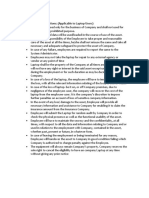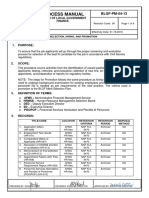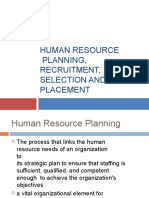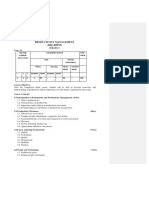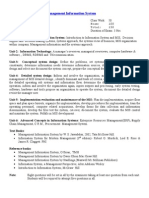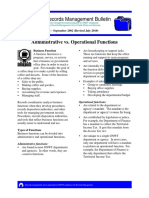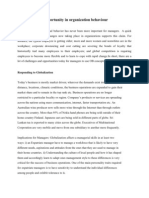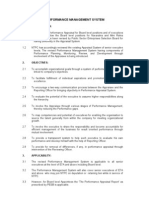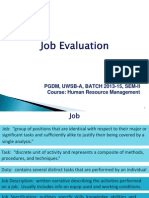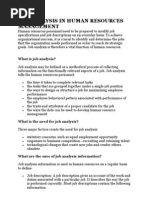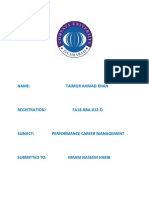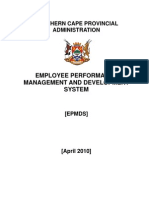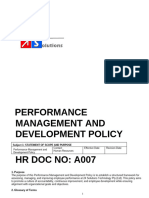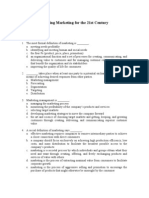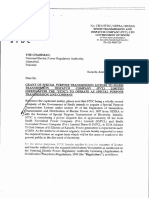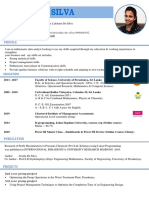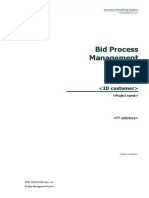Guide To Performance Management in The Civil Service
Guide To Performance Management in The Civil Service
Uploaded by
AnoushaCopyright:
Available Formats
Guide To Performance Management in The Civil Service
Guide To Performance Management in The Civil Service
Uploaded by
AnoushaOriginal Title
Copyright
Available Formats
Share this document
Did you find this document useful?
Is this content inappropriate?
Copyright:
Available Formats
Guide To Performance Management in The Civil Service
Guide To Performance Management in The Civil Service
Uploaded by
AnoushaCopyright:
Available Formats
GUIDE TO PERFORMANCE MANAGEMENT IN THE CIVIL SERVICE
ACRONYMS
AP HRM KPI KRA MC PA PAF PM PMF PMS PRB
Appeal Panel Human Resource Management Key Performance Indicator Key Result Area Monitoring/Moderating Committee Performance Agreement Performance Appraisal Form Performance Management Performance Management Framework Performance Management System Pay Research Bureau
GLOSSARY OF TERMS
Appraisee: The employee whose performance is being appraised Appraiser: The immediate supervisor of the appraisee. An officer responsible for the allocation of work, monitoring of activities, discussing performance and development and the performance review and assessment of an employee. Competencies: An element of knowledge, skill, or attribute that is directly related to effective performance in a job. Customers: People internal or external to the department with whom employees interact to provide a service. Development: Training and development activities employee's competencies and to improve performance. to enhance the
Feedback: Objective and timely information by the appraiser on the appraissees performance against set expectations and standards, understood by the staff member, and aimed at improving performance. Key Result Area (KRA): An area of a job in which performance is critical for making an effective contribution to the achievement of organizational strategies, goals and objectives. Key Task: objectives. The main task to be performed to achieve the Section/Units
Performance agreement: A document agreed upon and signed by an apprraisee and her or his appraiser, which includes a description of the job, selected KRAs, Key Tasks and Performance Standards, the appraisees personal development plan and competencies. Performance cycle: A 12-month period for which performance is planned, managed and assessed. It must be aligned to the same period as the Organisations annual plan. Personal development plan (PDP): A plan whereby the important competencies and other developmental needs of the appraisee are documented, together with the means by which these needs are to be satisfied and which includes time lines and accountabilities.
GLOSSARY OF TERMS Performance management: A purposeful, continuous process aimed at positively influencing employee behaviour for the achievement of the organizations strategic goals; the determination of the correct activities as well as the evaluation and recognition of the execution of tasks/duties with the aim of enhancing their efficiency and effectiveness; and a means of improving results from the Organisation, teams and individuals by understanding and managing performance within an agreed framework of planned goals, objectives, standards and support incentives. Performance standard: Performance standards are mutually agreed criteria to describe how well work must be done in terms of quantity, quality, timelines and cost. Strategic planning: This is the process by which top management determines the overall strategic direction and priorities, as well as the organizational purpose and objectives and how they are to be achieved. Strategic plan: The end product of strategic planning - setting out the mission and vision statements and the medium and long-term strategic objectives of the Organisation.
Table of Contents
Acronyms Glossary of Terms 1.0 Introduction
1 2 6 6 6 7 7
1.1 Background on Performance Management System 1.2 About this Document 2.0 3.0 4.0 Purpose of Performance Management System Scope and Application Integration of the Performance Management System with other HRM practices and management systems 5.0 The Institutional Framework
7 8 8 8 8 8 9 10 10 11 12 12 13 13 13 13 13 13 14 14 14
5.1 The Supervising Officer of Ministries/Departments 5.2 Heads of Sections/Units 5.3 Appraisers 5.4 Appraisees 5.5 The Head of Personnel Section 5.6 The Monitoring Committee 5.7 The Moderating Committee 5.8 The Appeal Panel 6.0 PMS Key Features 6.1 6.1.1 6.1.2 6.1.3 6.2 Overview Organisational level Section/Unit level Individual level Requirements of the PMS
6.3 PMS at organisation level 6.3.1 Overview 6.3.2 Procedure 6.4 PMS at section/unit level 6.4.1 Overview 5
6.4.2 6.5 6.5.1 6.5.2
Procedure PMS at individual level Overview Procedures A. Phase I Pre-appraisal B. Phase II Mid-appraisal C. Phase III Final Appraisal Appeal Moderation Procedures for assessing and scoring KRAs Procedures for assessing and scoring competencies Rating for overall performance Feedback on performance Reward
14 15 15 16 16 16 17 18 18 19 19 19 20 20 20 20 21 21 21 21
6.6 6.7 6.8 6.9 6.10 6.11 6.12 7.0 8.0 9.0
Confidentiality Records maintenance Inclusion of new officers in the PMS
10.0 Dealing with poor performance 11.0 Training 12.0 Evaluation
Annex A Annex B Annex C Annex D Annex E (Performance Appraisal Forms - PAF) (Understanding the PAF) (Ratings KRAs & Overall Performance) (List of Competencies) (Appeal Form)
1. 1.1
Introduction Background on Performance Management System
The impetus for a new Performance Management System (PMS) emerged from the need to build a modern and efficient civil service in Mauritius whereby the main focus would be on results and improvement in the delivery of services. Against this background, the Task Force on Performance Management set up in the context of Civil Service Reforms produced a Draft Performance Management Framework. The Framework made it compulsory for all Ministries/Departments to adopt corporate strategic planning and measure achievement of organizational objectives and divisional work targets against established performance indicators. Additionally, the Draft Performance Management Framework stipulated that the appraisal of employees should start with a performance agreement based on predetermined work plan, continued with regular reviews and completed with a general review of performance, assessment of development needs and recognition of performance. In line with the recommendations of the Task Force on Performance Management, the Pay Research Bureau (PRB) recommended inter alia that:(i) (ii) Ministries/Departments should evaluate and review periodically their performance in relation to established targets; They should adopt and implement a Performance Review Scheme as an integral part of Performance Management on a continuous basis; and The Ministry of Civil Service and Administrative Reforms should act as a coordinating Ministry, responsible to spearhead the introduction of the Performance Management System and inculcate a Performance oriented culture in the Public Service.
(iii)
1.2
About this document
The aim of this document is to provide a standardized and integrated framework to guide how performance is managed at both organizational and individual levels. The proposed framework is aligned with the recommendations of the 2003 PRB Report. More specifically, the purposes of this manual are to: State and clarify policies; Devise a PMS model for the civil service; Set out the institutional framework for PMS; Define responsibilities of all key players; and Identify the forms which must be completed as part of PM at individual level. 7
2.0
Purpose of Performance Management System The primary aim of the Performance Management System at Ministries/Departments is to improve performance by focusing on key areas of activity, which are identified through strategic planning processes. It seeks to establish clear links between organizational development, the delivery of quality services and the development of employees at work. It also purports to create a common bond of ownership among all employees as well as an environment where all individuals are developed, motivated and inspired to deliver a quality performance. In short, the main purpose of the new system is to manage and improve performance at all levels in the Ministries/ Departments
3.0
Scope and Application
The Performance Management System is applicable to all employees of the Ministries/Departments, regardless of seniority and occupation. The performance cycle is a 12-month period during which organizational, unit and individual performance is planned, practised and assessed. The performance cycle must correspond with the Ministries/Departments annual plan. However, planning for performance at all levels in the department must necessarily start before the appraisal period. 4.0 Integration of the Performance Management System with other HRM practices and management systems
The Performance Management System requires that the management of performance at individual level integrates with the management of performance at organizational and unit levels. To ensure that the system is effective, it must be seen as part of an integrated HRM system and not as an isolated event or tool and should take the following into consideration: Ministry vision, mission and values Departmental medium term strategic plans as well as annual plans and budgets Service delivery improvement plans Job descriptions Induction and orientation Job rotation Recognition programmes (non monetary) Employee personal development plans 9
Workplace skills plan
10
5.0
The Institutional Framework
To facilitate the implementation and sustainance of the PMS, the following key role players will assume the responsibilities outlined. 5.1 The Supervising Officer of Ministries/Departments (SO) The SO identifies the Key Result Areas (KRAs) in line with its strategic plan and the priorities that the Ministry/Department should deliver to its customers. The SO is responsible for the development and adoption of the strategic priorities of the Ministry/Department through the annual plans. The SO is responsible for ensuring that each section/unit of the department is assigned Key Performance Indicators (KPIs) drawn out of the departments strategic and annual business plans. The SO appoints the Monitoring Committee and the Moderating Committee in consultation with senior management, employee representatives and Head of Personnel Section. The SO ensures Ministry/Department. 5.2 the implementation of the PMS at the
The SO appoints the Appeal Panel in cases of appeal.
Heads of Sections/Units (HOS) The HOS are responsible for the achievement of objectives of the section/unit under their supervision. The HOS ensure that all members of staff have valid and up-todate job descriptions and that all Appraisers discuss and agree upon a Performance Agreement (PA) with every appraisee under their supervision.
5.3
Appraisers The Appraiser ensures that they explain the development of a PA to all appraisees under their supervision. They will then develop a PA jointly with each Appraisee. The Appraiser will clarify for Appraisees the objectives of the section/unit, the customers of the unit, the Appraisees job description, the Appraisees customers, agreed KRAs and competencies, Performance Standards and the actual rating on appraisal. They will also assist Appraisees to identify and incorporate training needs into their PAs. The Appraiser will also ensure that all forms are completed properly, accurately and in a timely manner.
5.4
Appraisees 11
All Appraisees of the Ministry/Department are responsible for clarifying with their immediate supervisors the dates and process for developing and submitting their PAs. Each Appraisee is responsible for developing a draft PA, based on the required objectives, KRAs and other aspects of their job that have been previously clarified by the Appraiser. The Appraisee is responsible for presenting the draft PA to the Appraiser for joint development of the final PA. To achieve this the Appraisee must ensure the following: Participate in performance planning at team and individual levels. Enter into performance agreement with her or his Appraiser. Execute tasks to achieve KRAs and competencies criteria. Keep personal records of successful achievements of outputs, as well as shortfalls, to facilitate meaningful communication/feedback when required. Seek support and guidance, if necessary. Be available and prepared for performance feedback and performance appraisal interview discussions. Communicate career, developmental and recognition aspirations to his or her supervisor/team leader. Identify customers, both fellow Appraisees in the department as well as others outside the department, establish their service requirements and obtain customer feedback on service provided. Take responsibility for own work plan and participation in the Performance Appraisal discussion.
5.5
The Head of Personnel Section (HOP)
This position is responsible for ensuring that all necessary support is provided in respect of the PMS: Distribute information on the PMS to all employees. Provide necessary instructions and forms to Appraisers. PAs and the schedule of duties/scheme of service of relevant staff are reconciled where necessary. Ensure that dates and process for submission of PA work plans, mid term reports and appraisal are adhered to. Maintain Personal Files where official Performance appraisals are kept. Provide the Moderating Committee and the Appeal Panel with data on PA development, progress reviews and appraisal. Provide on-going technical support to units and staff of the Ministry/Department.
12
Provide assistance to sort out divergence between the Appraiser and Appraisee. Follow up on recommendations made in the PAF. Assist the Monitoring Committee to conduct an audit of the PMS at the end of the Performance Cycle.
13
5.6
The Monitoring Committee
The Monitoring Committee is chaired by the Head of Ministry/Department or a senior officer delegated by him and includes, among others the Head of Reforms Unit. Its main function is to ensure the smooth implementation and sustenance of PMS. The Monitoring Committee has the following responsibilities: Obtain feedback on the functioning of the PMS with a view to detecting potential problems and identifying areas for improvement in the system and its procedures. Provide all logistic support and resources for improving system effectiveness and give appropriate instructions for corrective measures in problem areas. Periodically measure the performance of the organisation through identified performance indicators and review strategic priorities and annual plans on regular basis. Report to the Committee. Central Performance Management Monitoring
5.7
The Moderating Committee
The Moderating Committee, consisting of at least 3 members is appointed by the Supervising Officer in consultation with senior management and employee representatives, and should be chaired by the Head of Reforms Unit of the Ministry/ Department. The Moderating Committee has the following responsibilities: Monitor the PM process to ensure that performance standards are set and applied consistently and realistically to employees on the same level in the Ministry/Department. In cases where deviations from norms and standards are identified, they must refer these back to the relevant Appraiser for review. Detect potential problems in the system through the Personnel Section, report on PA development and progress reviews and make recommendations for corrective action. Review overall assessment ratings, based on report by the HOP. Ensure procedures for appraisal are consistently adhered to and are equitable. Deal with resolution of conflicts.
14
5.8
The Appeal Panel (AP)
The Appeal Panel is appointed by the Supervising Officer in cases of appeal made by Appraisees who are not satisfied with the ratings/recommendations regarding their performance. The Panel would be made of 3 members, selected with due regard to the status of the appraisee and comprising one Union representative. Members should not be directly or indirectly involved in the appraisal of the officer. The appraisee may be accompanied by an officer of his choice or his union representative. The AP has the following responsibilities: Investigate into cases referred to the Panel. Inform the Supervising Officer and the Monitoring/Moderating Committee of the findings of the enquiry. Submit findings/reports within 30 days of the setting up of the Panel.
The findings of the Panel should be final.
15
6.0 6.1
PMS Key Features Overview
The PMS integrates all levels of the organisation starting from the Head where planning is performed down to the individuals who conduct the dayto-day tasks. As can be seen from Figure 1, there are three main levels that make up the PMS organisation, section/unit and individual.
Government objectives, priorities & mandates
PMS at section/unit level PMS at organisation level
Strategic Plan
Performance Review Moderation
PMS CYCLE
PMS at Individual level
Performance Agreement Work Plan Development Plan Moderation
Progress Review Mid-term review Moderation
Figure 1: PMS Cycle
16
6.1.1 Organisational level The Supervising Officer determines the strategic priorities, and the overall KRAs and KPIs for each of the priorities for the Ministry/Department. He then assigns KRAs and KPIs for each section/units. Based on the latter, Section/Unit plans are developed by the sections/units. 6.1.2 Section/Unit level The different sections/units help in the achievement of their plans by undertaking specific activities. 6.1.3 Individual level Each appraisee develops a PA with his/her appraiser and his/her performance is appraised at the end of the performance cycle. 6.2 Requirements of the PMS
The key requirements for the implementation of the system are: Institutional Framework The roles of the different key players are defined. Strategic Plan Based on its vision, mission and strategic objectives, priorities and specific objectives of the sections/units of the organisation are set out. Section/Unit Plan This enables the sections/units to determine their KPIs. Performance Agreements These enable the assignment of the work plan and Performance Standards to individuals. 6.3 PMS at organisation level
6.3.1 Overview The PMS helps the organisation to translate overall strategic priorities and its strategic plan (vision, mission and strategic objectives) into performance indicators to measure the overall organisational performance. They focus on long-term outcomes rather than short-term outputs. The strategic plan enables the definition of: 17
Objectives for the KRAs of the Ministry/Department; and KPIs for the department which show the achievement of the priorities identified in the strategic plan.
6.3.2 Procedure The Supervising Officer and senior management will develop the objectives and measurement at organisation level as follows: 6.4 Develop objectives and KRAs for the Ministry/Department. Develop KPIs for each KRA. Develop process and time frames for incorporation of Performance Standards into PA of officers at senior management level. Develop process and time frames for development of plans for the section/unit or senior management team members. Develop a monitoring system. Conduct monitoring and measurement of Performance against KPIs and Performance Standards at least every 6 months. Evaluate Performance for each objective. Evaluate Performance Ministry/Department. for overall objectives of the
Insert overall Performance into the Supervising Officers performance contract. Review achievement/non-achievement department. of objectives of the
Document issues for incorporation into the revision of the strategic plan.
PMS at section/unit level
6.4.1 Overview PM at section/unit level focuses on outputs and activities that lead to achievement of overall outcomes of the Ministry/Department. The Heads of Section set out the objectives at the sections/units which are derived from the Section/Unit plan. 6.4.2 Procedure Develop KPI for each KRA/objective. Indicate constraints of some of the KPIs. Incorporate responsibilities into PA of Heads of Sections/Units. Conduct monitoring and measurement of performance against KPIs and Performance Standards at least every 6 months. Evaluate performance for each objective. 18
Evaluate performance for overall objectives of Sections/Units. Review achievement/non-achievement of objectives of Sections/Units.
19
6.5
PMS at individual level
6.5.1 Overview PM at the individual level is an on-going interactive process between an employee and his/her supervisor. As shown at Figure 2, the performance appraisal process, covering a twelve month period consists of 3 phases: Pre-appraisal Planning and agreeing on Performance Mid-appraisal Managing Performance Final-appraisal Appraising/reviewing Performance
Pre-appraisal Planning Performance
Final appraisal Reviewing Performance
Mid-appraisal Managing Performance
Figure 2: Performance Appraisal Process All relevant information pertaining to the Performance of the individual are recorded on a Performance Appraisal Form (PAF) (Annex A & A1 (Worksmen Group)). At Annex B is a guide to the PAF. This is a record of an officers individual performance and contribution to the achievement of the Ministry/Departments strategic goals and objectives for a given period. The original of the form should be kept by the Appraiser and handed over to the Personnel Section after the final appraisal phase. A copy of the form is kept by the Appraisee. If an employee changes job at the same level during the Performance Cycle, a new PA must be entered for the new role and the performance appraisal would take both periods of work into consideration.
20
6.5.2 Procedures A. Phase I Pre-appraisal This is the starting point of the process. It is the Appraisers responsibility to ensure that his staff is clear about what is involved. Both the Appraiser and the Appraisee have to sit down and identify objectives for the performance period. This will increase commitment to achieving the objectives. At this stage, the officer being appraised and the Appraiser sort out anything that they feel may get in the way towards achievement of the objectives that will be agreed upon. The pre-appraisal session denotes two-way communication. It is important to answer any questions the employee might have about the appraisal process in general or in the specific post. The Appraiser should clearly indicate the priorities on different aspects of the Appraisees job, essential job functions and the criticality of expected results. This is a time where the Appraiser and the Appraisee should discuss performance. Steps Appraisee fills in section 1 of the PAF Appraisee and Appraiser discuss the work plan for the period. The work plan consists of the jobs KRAs/Key tasks and the Performance Standards. The workplan also provides for the identification of the competencies required for the effective performance of the job Appraisee and Appraiser agree on the workplan and fill in section 2.
B.
Phase II Mid-appraisal The mid-appraisal period is the time during which the Appraisee performs assigned work responsibilities. Part of the Appraisers responsibility is to observe, document and monitor performance. If an Appraisees Key Tasks change during the course of a midappraisal period, the changes should be noted on the Performance Appraisal Form. Any new Key Tasks should be added to the form with the corresponding date. Any Key Tasks that are no longer being performed should be highlighted and a date added as to when the Key Task was no longer performed by the Appraisee. Any modification to the Performance Appraisal Form should be initialled by the Appraiser and Appraisee. Three months of performance is the minimal period of time sufficient to observe an employee for a reliable evaluation. The Appraiser should use good judgment of timing when modifying, adding or deleting Key Tasks. 21
Informal communication and feedback should take place between the Appraiser and Appraisee. Activities There is on going documentation performance of Appraisee by Appraiser. Continuous informal communication between Appraiser and Appraisee. and and monitoring feedback of
flows
Appraiser coaches Appraisee as and when required. At mid-term of the phase, the Appraiser conducts a formal interview with the Appraisee to review and record progress made on the performance agreement. The purpose of the review is to motivate and reveal to the Appraisee areas that need improvement and if required, to modify the PA. Steps Appraiser fixes the mid-term appraisal meeting and informs the Appraisee well in advance (preferably 2 weeks before). Appraisee fills in sections 3.1 & 3.2 and submits the original PAF to Appraiser. During the mid-term meeting, Appraiser and Appraisee discuss on progress achieved on PA and fill in sections 3.3 and 3.4 of PAF. Identified weaknesses are monitored in order to help the employee to improve. Achievements to be recognized where appropriate.
C.
Phase III Final Appraisal The final appraisal period is considered the end result of the appraisal process. At this point the Appraiser reviews, evaluates and documents the performance of the appraisee during the appraisal period. The Appraiser considers the appraisees performance of KRA/Key Tasks while reviewing documentation and seeking input from other appropriate sources as the case may be. Then the performance is to be compared to what was listed during the preappraisal. The KRA/Key Tasks are rated based on the performance level as discussed in the pre-appraisal phase. The final Appraisal interview is designed to give the Appraisee specific performance information in regard to good performance and to provide any pertinent suggestions for improvement. 22
The Appraiser prepares thoroughly for the appraisal session and has the form and factual information ready to present at the proper time during the appraisal feedback session. The Appraiser must be ready to respond to any questions regarding the reasons for the ratings. Action plans are developed for deficient areas. This action plan may be developed by the Appraiser with the Appraisee during the final appraisal session. An action plan identifies the following factors: 1. 2. 3. 4. The improvement required and the time frame for same. The explanation of expected results or work conduct. A follow-up date at the end of the set time frame to discuss progress. Any assistance that will be provided by the Appraiser.
This type of communication and documentation allows ample opportunity for an appraisee to adhere to the expected results for the post during the next appraisal year. An action plan can be used anytime during the year to help correct performance but is beneficial at final appraisal also. It is extremely important to allow sufficient time for the employee to ask questions and discuss any performance topics. Steps Appraiser fixes the final appraisal meeting and informs the Appraisee well in advance (preferably 2 weeks before). Appraisee fills in sections 4.1 & 4.2 and submits the original PAF to Appraiser at least a week before the scheduled date for the meeting. During the final appraisal session, Appraiser and Appraisee discuss on achievements of PA and fill in sections 4.3, 4.4, 5 and 6 of PAF.
6.6
Appeal
An Appraisee who is not satisfied with the ratings/remarks given by the Appraiser makes a request for appeal to the Supervising Officer through the Appraiser within 5 working days of performance appraisal meeting by filling in the Appeal Form (Annex E). The Appraiser submits the request for Appeal to the Supervising Officer together with his comments within 1 week of receiving the request. A copy of the request is forwarded to the Monitoring/ Moderating Committee. The Supervising Officer sets up an Appeal Panel within one week to investigate into cases of appeal. 23
6.7
Moderation
The Supervising Officer is required to appoint a Moderation Committee made up of senior officers that can assist in ensuring that there is equity and consistency in the application of the Performance Appraisal at all levels. The moderation process operates at two different levels of performance management. At the systems level the Moderation Committee must satisfy itself that organization and section objectives are developed in a consistent manner and that the PMS systems and procedures are being adhered to. At the individual employee level the role of the Moderation Committee is primarily to ensure that Appraisers are setting and agreeing workplans and are appraising Performance in a realistic, consistent and fair way across the organization. The Moderation Committee is required to meet at least thrice per performance cycle at the start of the pre-appraisal phase to moderate and approve the results of the performance planning and performance agreement activities, in the middle of the appraisal cycle to sort out any divergence and at the end of the final stage to moderate and approve the outcomes of the appraisal process. 6.8 Procedures for assessing and scoring KRAs The Appraisers should: Address each individual KRA/Key task in terms of the requirement, with emphasis on the outputs and their measures and the actual achievement against these outputs. Read the descriptive statements associated with each of the five levels of performance as set out at Annex C. The number associated with the statement that best describes the achievement of the job holder is chosen. The number associated with the statement is the score that is assigned to the KRA for overall appraisal score calculations. 6.9 Procedures for assessing and scoring competencies
The procedure for scoring competencies is similar to that for scoring KRAs/Key Tasks. Only those competencies selected for the inclusion in the PA are assessed. However, a minimum quantum of competencies that best fit the requirements of the job is chosen (at least10 competencies for the Professional, Technical and Administrative Groups and 5 for the Workmens Group). The standard rating scale for competencies is at Annex D. 6.10 Rating for overall performance
24
The overall performance rating is the combination of the average KRA score and the average competencies score. KRAs are weighted at 70% and competencies at 30% of the overall score. Overall Performance rating: Average score for KRAs X + Average score for competencies X 0.3 0.7
6.11 Feedback on performance The phases of the PM cycle at individual level should be conducted in a participative and transparent manner. All signatures on the PAF are mandatory. The signature of the Appraisee acknowledges the fact that the appraisal has been discussed but does not necessarily denote agreement. The Appraiser maintains the original PAF to use in completing the employee performance appraisal. Moderation of the outcomes of the appraisal system may result in assessment scores being altered. The Appraisee should be informed accordingly. 6.12 Reward The PRB Report 2003 mentioned that rewards would be linked to performance but the issue would be finalised at a later stage. 7.0 Confidentiality
The information contained in a PAF is confidential and care should be taken to protect the Appraisees right to privacy. 8.0 Records maintenance (a) At individual level Each employee should receive a copy of the PAF.
The rating appraiser maintains the appraisee PAF until completion of the final appraisal phase. After the final appraisal phase, the original PAF is forwarded to the Personnel Section. A copy is kept by the rating appraiser and the appraisee. 25
(b)
At Organisational Level
Records pertaining to PMS at organisational and section/unit is maintained by the Supervising Officer or to a senior officer delegated by him. A copy is kept by Heads of Sections/units.
26
9.0
Inclusion of new officers in the PMS
All new members are required to sign a PA within 1 month of joining the department. The Personnel Section is required to ensure that all new employees are given an appropriate training on the PMS.
10.0 Dealing with poor performance The PMS monitoring and review stages enable the early identification and resolution of poor performance. Some of the options open to the Appraiser for overcoming poor performance are: Personal counselling. On-the-job coaching. Training. Redefining the PA.
Work environment audits to establish whether there are other factors affecting performance. Should the employee not respond to such initiatives, action may be taken according to existing rules and regulations. 11.0 Training
The PMS enables to define individual training and developmental needs and to evaluate the impact of training on performance. The Supervising Officer should ensure that training and developmental needs of all officers identified during the PM exercise are included in the training plan of the Ministry/Department. 12.0 Evaluation
An evaluation exercise should be carried out at the end of the PMS Cycle to determine the effectiveness of the system. This should be done by the Head of Personnel Section in consultation with the Monitoring/Moderating Committee.
27
You might also like
- 2023 OBE Syllabus Business Office Management and TechnologyDocument14 pages2023 OBE Syllabus Business Office Management and TechnologyJeffreyReyesNo ratings yet
- How To Get To $10M in ARR and Beyond Book (Notion Capital Foreword)Document162 pagesHow To Get To $10M in ARR and Beyond Book (Notion Capital Foreword)Abeed100% (2)
- 5.34 Recruitment Selection & Placement ProcedureDocument7 pages5.34 Recruitment Selection & Placement Procedurejawad0% (1)
- E. Terms and Conditions: (Applicable To Laptop Users)Document1 pageE. Terms and Conditions: (Applicable To Laptop Users)raviNo ratings yet
- Selling Skills WorkbookDocument25 pagesSelling Skills WorkbookalokmenoninNo ratings yet
- Leadership Styles A Case of Two Hospitals in The USDocument23 pagesLeadership Styles A Case of Two Hospitals in The USWagiono Suparan100% (2)
- Arima Kousei QuizDocument2 pagesArima Kousei QuizKen Alob100% (2)
- Customized Spms2Document109 pagesCustomized Spms2Sadylie Pelle100% (1)
- SPMSDocument15 pagesSPMSMamertzdpogi LVS,.inc.No ratings yet
- Presentation - Strategic Performance Management System - Jennifer TimbolDocument38 pagesPresentation - Strategic Performance Management System - Jennifer TimbolProfile InfoNo ratings yet
- Coa M2015-008Document17 pagesCoa M2015-008Althea GRace AlvarezNo ratings yet
- Memo 1 - Submission of Rank and File IPCR SLIPR For 2016 Sem 2Document4 pagesMemo 1 - Submission of Rank and File IPCR SLIPR For 2016 Sem 2Sam LagoNo ratings yet
- Challenge Exam - Recruitment and Selection Outline 2010Document11 pagesChallenge Exam - Recruitment and Selection Outline 2010tusharhrmNo ratings yet
- Personnel AdministrationDocument59 pagesPersonnel AdministrationSURAJ SINGH VAISH100% (1)
- Travel Reimbursement Flow Chart Narrative ReportDocument4 pagesTravel Reimbursement Flow Chart Narrative Reportmeldgyrie mae andalesNo ratings yet
- Merit Promotion PlanDocument91 pagesMerit Promotion PlanKapitan BilangNo ratings yet
- The Functions of Human Resources DepartmentDocument14 pagesThe Functions of Human Resources DepartmentGrandpaGyu InSpiRiTNo ratings yet
- DepEd Order No Overtime PayDocument7 pagesDepEd Order No Overtime PayRichardDumlaoNo ratings yet
- HRD Recruitment Selection and HiringDocument8 pagesHRD Recruitment Selection and Hiringrowilson rey100% (1)
- HR Initiatives of Civil ServiceDocument7 pagesHR Initiatives of Civil Serviceszarielle yumikoNo ratings yet
- Job AnalysisDocument35 pagesJob AnalysisSinha PrakharNo ratings yet
- Merit Promotion Plan Revised PoliciesDocument5 pagesMerit Promotion Plan Revised PoliciesPrincess Camille Tangpus100% (3)
- Employee Performance Management PolicyDocument3 pagesEmployee Performance Management Policyone d courier expressNo ratings yet
- Q1 Functional Organization Has Been Divided To Put The Specialists in The Top Position Throughout The EnterpriseDocument7 pagesQ1 Functional Organization Has Been Divided To Put The Specialists in The Top Position Throughout The EnterpriseSneha ShadiNo ratings yet
- Chapter Three: The Development of HRDocument76 pagesChapter Three: The Development of HRethnan lNo ratings yet
- Public OfficeDocument6 pagesPublic OfficeDo HungNo ratings yet
- Administrative Assistant IIIDocument5 pagesAdministrative Assistant IIIVincent Joel Losentes Uy0% (1)
- 3) 30 Most Common Problems in Management and How To Solve Them PDFDocument58 pages3) 30 Most Common Problems in Management and How To Solve Them PDFHya Ciinth BaloncioNo ratings yet
- A Guide To Strategic Human Resource Planning 109Document15 pagesA Guide To Strategic Human Resource Planning 109Don DulceNo ratings yet
- ERP Syllabus (Final)Document2 pagesERP Syllabus (Final)Amar MudirajNo ratings yet
- D I S 5 M, 2018: Eployment and Mplementation TageDocument51 pagesD I S 5 M, 2018: Eployment and Mplementation Tagesaad aliNo ratings yet
- 6 02 4 Training EvaluationDocument2 pages6 02 4 Training EvaluationAhmed GoudaNo ratings yet
- SBN-1006: Salary Standardization Law VDocument8 pagesSBN-1006: Salary Standardization Law VRalph Recto100% (1)
- Chapter 8 Orientation The Acculturation ProcessDocument7 pagesChapter 8 Orientation The Acculturation ProcessLuke Thomas100% (3)
- 3.6 - Selection, Placement, Training and Development.Document50 pages3.6 - Selection, Placement, Training and Development.nandhiniNo ratings yet
- Unit-5b Recruitment, Selection and InductionDocument34 pagesUnit-5b Recruitment, Selection and InductionAlisha DeltaNo ratings yet
- Productivity ManagementDocument2 pagesProductivity ManagementAnil MarsaniNo ratings yet
- Mis SyllabusDocument1 pageMis Syllabusahmadfiroz100% (2)
- Manual of Compensation - DBM Chapter 3Document113 pagesManual of Compensation - DBM Chapter 3Aris Solis100% (2)
- Admin MattersDocument85 pagesAdmin MattersJoana-MariNo ratings yet
- National College of Public Administration and GovernanceDocument11 pagesNational College of Public Administration and GovernanceIvan Harris TanyagNo ratings yet
- HRM - The Role of The HR PractitionerDocument8 pagesHRM - The Role of The HR Practitionercons the100% (1)
- Changes in Personnel Status (Autorecovered)Document5 pagesChanges in Personnel Status (Autorecovered)Christine Joy RodriguezNo ratings yet
- Admin Vs OperationalDocument2 pagesAdmin Vs OperationalGlen LunaNo ratings yet
- Using Job Analysis and Competency Modeling As The Foundation For The HR SystemDocument17 pagesUsing Job Analysis and Competency Modeling As The Foundation For The HR SystemMariele Manlagnit ColumnaNo ratings yet
- 1.6challenges and Opportunity For Organization Behaviour 1Document13 pages1.6challenges and Opportunity For Organization Behaviour 1Balakrishna Nalawade N0% (1)
- Performance Management SystemDocument17 pagesPerformance Management SystemAnjusha NairNo ratings yet
- OPIF Manual (Philippines)Document40 pagesOPIF Manual (Philippines)darellejaide100% (3)
- Prime HRM Form 2 Hrmo Self Assessment Mar 20Document12 pagesPrime HRM Form 2 Hrmo Self Assessment Mar 20parautang100% (1)
- Strategic Performance Management SystemDocument3 pagesStrategic Performance Management SystemMaham FatimaNo ratings yet
- CSC Leadership ProgramDocument2 pagesCSC Leadership ProgramjackNo ratings yet
- What Is An HR Maturity Level?Document20 pagesWhat Is An HR Maturity Level?Cha Magaoay Tamani100% (1)
- HRM Job EvaluationDocument13 pagesHRM Job EvaluationPaul Nelson100% (1)
- Final Exam-Theories and Principles of ManagementDocument6 pagesFinal Exam-Theories and Principles of ManagementVincent ViasonNo ratings yet
- Masteral 206Document3 pagesMasteral 206Retro Sphinx86% (7)
- Strategic Performance Management SystemDocument22 pagesStrategic Performance Management SystemMichelleneChenTadle100% (2)
- Job Analysis in Human Resources ManagementDocument13 pagesJob Analysis in Human Resources ManagementNolzen Torres100% (1)
- SPMS ReportDocument36 pagesSPMS ReportCharmaine Teodoro ParejaNo ratings yet
- Performance Appraisal System in The Cyprus Civil ServiceDocument23 pagesPerformance Appraisal System in The Cyprus Civil ServiceBETELHEM ABDUSHE0% (1)
- PCM Case Study 11.1 Assign Taimur 012Document4 pagesPCM Case Study 11.1 Assign Taimur 012AimeeNo ratings yet
- 24 Solutions Performance Management and Development PolicyDocument12 pages24 Solutions Performance Management and Development PolicyJoyce RatomboNo ratings yet
- EPMDS April 2007 v6 (2) 2Amended-FinalDocument22 pagesEPMDS April 2007 v6 (2) 2Amended-FinalBallerboy100% (1)
- 24 Solutions Performance Management and Development Policy - 007Document12 pages24 Solutions Performance Management and Development Policy - 007Joyce RatomboNo ratings yet
- Performance Management System of Bank AlfalahDocument17 pagesPerformance Management System of Bank AlfalahWaqaz Jamil80% (5)
- Case Study Chapter 2Document2 pagesCase Study Chapter 2AnoushaNo ratings yet
- A) Business ObjectivesDocument4 pagesA) Business ObjectivesAnoushaNo ratings yet
- Product Orientation, Market Orientation and Asset-Led MarketingDocument3 pagesProduct Orientation, Market Orientation and Asset-Led MarketingAnoushaNo ratings yet
- Team and QualityDocument3 pagesTeam and QualityAnoushaNo ratings yet
- Case Study Sources of FinanceDocument2 pagesCase Study Sources of FinanceAnoushaNo ratings yet
- Corporate Social Responsibility Initiatives: An Analysis of Voluntary Corporate DisclosureDocument19 pagesCorporate Social Responsibility Initiatives: An Analysis of Voluntary Corporate DisclosureAnousha100% (1)
- Defining Marketing For The 21st CenturyDocument14 pagesDefining Marketing For The 21st CenturyAnoushaNo ratings yet
- CSR and Employee RetentionDocument5 pagesCSR and Employee RetentionAnoushaNo ratings yet
- Marketing Assignment FinalDocument36 pagesMarketing Assignment FinalAnoushaNo ratings yet
- Foundations of Multinational Financial Management: Babasab PatilDocument29 pagesFoundations of Multinational Financial Management: Babasab PatilBabasab Patil (Karrisatte)No ratings yet
- Project Report On Air India - 151859407Document33 pagesProject Report On Air India - 151859407Sathriya SudhanNo ratings yet
- Invoice 14002188 PDFDocument1 pageInvoice 14002188 PDFĦøÐâNo ratings yet
- Filename: Sind Transmission & Dispatch Company (STDC) PDFDocument61 pagesFilename: Sind Transmission & Dispatch Company (STDC) PDFYasir Raza Memon100% (1)
- SDL Translation Management Systems ExplainedDocument22 pagesSDL Translation Management Systems Explainedgs.123No ratings yet
- Indian IT Industry (Information Technology)Document41 pagesIndian IT Industry (Information Technology)Matthew WilliamsNo ratings yet
- Class Xi Account 2017Document4 pagesClass Xi Account 2017nishashrma1980100% (1)
- Astral 2018Document12 pagesAstral 2018Jupe JonesNo ratings yet
- Lean and Accounting: The Role of The CEO and CFO: Orest J. Fiume Retired Vice President - Finance The Wiremold CompanyDocument44 pagesLean and Accounting: The Role of The CEO and CFO: Orest J. Fiume Retired Vice President - Finance The Wiremold Companyjitendrasutar1975No ratings yet
- Conceptual Framework of Financial Accounting and ReportingDocument9 pagesConceptual Framework of Financial Accounting and ReportingOyeleye TofunmiNo ratings yet
- 2 .The Invoice 2.1 Types of InvoiceDocument3 pages2 .The Invoice 2.1 Types of InvoiceIfrah SajidaNo ratings yet
- Irosha de SilvaDocument3 pagesIrosha de SilvaSameera LakmalNo ratings yet
- Resume - 2021Document3 pagesResume - 2021balaNo ratings yet
- قوانين الاقتصاد الجزئيDocument3 pagesقوانين الاقتصاد الجزئيdido bouNo ratings yet
- Chapter 5-EcomBusinessStrategiesDocument40 pagesChapter 5-EcomBusinessStrategiesShahinur FerdoushNo ratings yet
- Susan Chong Becomes First Female President of Enterprise 50 AssociationDocument1 pageSusan Chong Becomes First Female President of Enterprise 50 AssociationWeR1 Consultants Pte LtdNo ratings yet
- Affiliate Marketing Partner Program: The Texpo EnergyDocument6 pagesAffiliate Marketing Partner Program: The Texpo Energykhan4luvNo ratings yet
- Bid Process ManagementDocument32 pagesBid Process ManagementJoeri BoeckxNo ratings yet
- Game TheoryDocument10 pagesGame Theoryaditya kumarNo ratings yet
- S.no Customer Name Contact No Serial Number: 22 M/s.M.N.Achha & Co 2225372 4L67bAAQ900926HDocument52 pagesS.no Customer Name Contact No Serial Number: 22 M/s.M.N.Achha & Co 2225372 4L67bAAQ900926HSrinivas Gutla100% (1)
- Management Lessons From The Movie Rocket SinghDocument11 pagesManagement Lessons From The Movie Rocket Singhvikramsingh70No ratings yet
- Admin Tasks 2024Document2 pagesAdmin Tasks 2024rhandzNo ratings yet
- Cbjessco 42Document4 pagesCbjessco 42pujaNo ratings yet
- Valuation Shares GoodwillDocument3 pagesValuation Shares Goodwillmalti jNo ratings yet
- Presentation - The Story Behind The Growth of Indian Software IndustryDocument29 pagesPresentation - The Story Behind The Growth of Indian Software IndustryASHISH RANJANNo ratings yet
- FA2 Syllabus and Study Guide - Sept 22-Aug 23Document14 pagesFA2 Syllabus and Study Guide - Sept 22-Aug 23Ahmed RazaNo ratings yet



